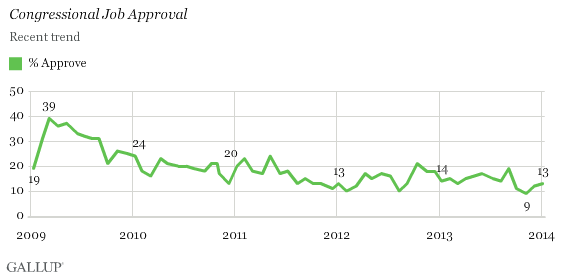The U.S. Constitution was a compromise. Originally the members of the House of Representatives were to be popularly elected, while the members of the Senate were to be appointed by state governments. Later senators came to be elected by the citizens of their states. State governments have considerable leeway in the way that they define the districts from which individual representatives are elected.
gerrymander: to manipulate the boundaries of (an electoral constituency) so as to favor one party or class.How does this work out in practice. I draw from this article from The Nation:
In 2014, Republicans received about 52 percent of votes cast for the House of Representatives. However, they now hold about 57 percent of the seats in the House. Why do they hold a greater portion of seats than the portion of votes that they received? Because in districts in which Democrats won, they tended to win big and in districts in where Republicans won, they tended to gain narrow victories. Why? I suggest that Republican state legislatures were by and large more successful in gerrymandering their states so that Democrats were packed in highly Democratic districts.
"In 2012, Republicans won a lopsided majority of seats despite securing only 48 percent of the vote." Same reason.
A further reason for the imbalance: In the most recent election, 96 percent of running incumbents won reelection. Once a party gains a significantly large majority in the House of Representatives, since the incumbents tend to be reelected (and since they tend not to retire at any reasonable age), that party tends to stay in the majority.
Remember that the Congress, with its Republican majority in the House of Representatives, enjoyed a 9 percent approval rating in November 2014, when the Republicans increased their majority.
 |
| Source |
An Example of Reform
California, in 2008, passed a plebiscite, the Voters FIRST Act. I quote from Wikipedia:
It removed from the California Legislature the responsibility for drawing the state's congressional districts, and gave the responsibility instead to a 14 member Citizens Commission. It also required that the districts drawn up (1) comply with the federal Voting Rights Act; (2) make districts contiguous; (3) respect, to the extent possible, the integrity of cities, counties, neighborhoods and "communities of interest"; and (4) to the extent possible, make districts compact. Several of these terms are not defined in law......
The California Citizens Redistricting Commission certified final district maps on August 15, 2011, and they took effect with the 2012 election. The new districts are described as more "purple" than "red" or "blue" - that is, more mixed in electoral composition compared to the mostly "safe" districts of the previous decade, where incumbents were almost guaranteed re-election. An interactive map comparing the old districts with the new ones is available via the Los Angeles Times.

No comments:
Post a Comment